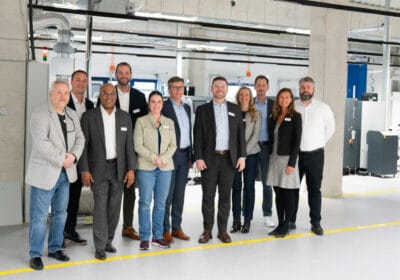Mitsubishi Electric’s SafePlus option helps to turn hundreds of industrial robots into co-operative solutions
Collaborative and co-operative robotic solutions that work together with humans are on the rise, as they can support operators on the factory floor and enhance their output. Mitsubishi Electric has increased the availability of this technology significantly with the release of the MELFA SafePlus robot safety system. This latest option allows any of the over 160 MELFA FR-series intelligent industrial robot models to be converted into a co-operative system.
Key features of the SafePlus option include robot positioning and monitoring functions, as well as Blue Danube Robotics’ AIRSKIN® cover, a pressure sensitive safety skin that further helps to reduce the robot’s force and stop it if a collision occurs.
As human-machine interactions continue to advance in sophistication and increase in popularity, robots need to be able to safely work alongside human operators in an uncaged environment. To achieve this, co-operative robots need to promptly detect any intrusion into their working area and adapt accordingly, either slowing down or stopping. The removal of safety guards contributes to maximising the factory space available and increases productivity for individual production cells.
The latest MELFA SafePlus solution offers a number of new features in order to make it safer, easier and more efficient when turning Mitsubishi Electric’s industrial robots into co-operative machines that do not need safety cages. The technology can be applied to both horizontal SCARA and vertical articulated arm robots used in a broad range of industries.
The MELFA SafePlus solution from Mitsubishi Electric includes safety monitoring functions that allow the robot to adapt to different conditions. For example, robots implementing SafePlus can avoid certain operational areas when occupied by humans (Limited Range Control), stop (Safe Stop) or reduce their speed when human operators are in their vicinity (Reduced Speed Control) as soon as the area is clear, the robot can return to its normal high speed operation.
Further enhancements have increased the robots’ capabilities to safely operate close to humans and within other space constraints, MELFA SafePlus can now bring human-machine co-operation to a new level. As a result, the number of emergency stops is reduced and machine uptime is maximised, positively affecting productivity.
Increased reliability and flexibility
The latest version of SafePlus features more than safety monitoring and collision detection functions, which are fundamental for co-operative operations. Safety logic editing, speed and positioning monitoring functions contribute to a higher safety performance.
The position monitoring function not only controls the position of the robot but also external movements in up to eight designated areas around the machine. As a result, the robotic arm can adapt its behaviour in real-time on the basis of what is happening in its proximity. For example, the robot can reduce its speed, avoid moving towards the obstacle or stop.
Previously, SafePlus allowed the robot to reduce its speed when operators were present by defining a cubic speed monitoring area with equal x, y and z safety distances, it is now possible to create asymmetrical areas, where the safety distances differ. In fact, objects lying in directions where the robot does not move do not create an obstacle. Therefore, the safe distances in these directions can be minimised, thus safely reducing emergency stop downtime and allowing applications in tighter spaces.
In addition, end users have the flexibility to easily construct and operate safety systems that address their intended applications. Safety monitoring conditions and operating parameters can be configured directly in the robot controller, without the need for specific safety CPUs.
Also, Mitsubishi Electric has increased the number of duplicated safe I/O inputs and outputs available in the system, contributing to the creation of more reliable and flexible safety systems.
Increasing touch sensitivity
Besides the new functionality featured in SafePlus, Mitsubishi Electric has also optimised the safety monitoring and collision detection functions.
The safety measures used by SafePlus are certified by the leading independent and impartial certification body, TÜV SÜD, to ensure compliance with international IEC and EN standards, such as EN 61800-5-2 on safe motion and EN 60204 on safety stop. This third-party testing attests to Mitsubishi Electric’s commitment to deliver high-quality, reliable solutions to its customers.
The company also boosted the system’s collision detection capabilities by applying AIRSKIN safety pads onto its FR-series robots that integrate with SafePlus. The solution, compliant with ISO 13849 (PLe) and IEC 62061 (SIL3) safety standards, features a soft structure, designed to reduce the impact of the moving robotic arm.
In addition, if safety sensors on the surface of the cover detect any pressure, e.g. due to a collision with an object, different operations can be programmed.
Barry Weller, Product Manager at Mitsubishi Electric, comments: “Mitsubishi Electric’s FR-series offers high performance for industrial applications. By combining them with MELFA SafePlus, users can employ these robotic arms for new tasks and use them in more environments.
“Our latest safety solution is a big step forward for safe, automated, co-operative work applications. By offering increased flexibility, reliability and ease of use, our technology helps manufacturers to boost their productivity and uptime, even in confined spaces, by promoting a safer and more productive interaction between humans and robots.”







